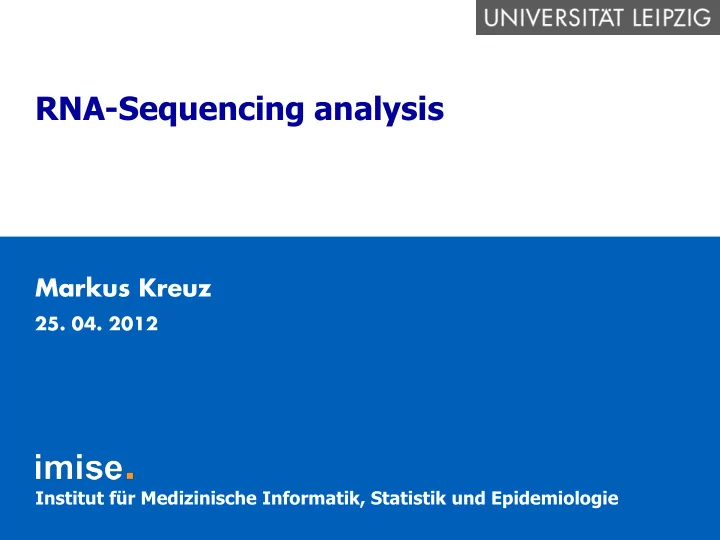

RNA-Sequencing analysis Markus Kreuz 25. 04. 2012 Institut für Medizinische Informatik, Statistik und Epidemiologie
Content: Biological background Overview transcriptomics RNA-Seq RNA-Seq technology Challenges Comparable technologies Expression quantification ReCount database RNA-Seq - Overview 2
Biological background (I): Structure of a protein coding mRNA Non coding RNAs: Type Size Function microRNA (miRNA) 21-23 nt regulation of gene expression small interfering RNA (siRNA) 19-23 nt antiviral mechanisms piwi-interacting RNA (piRNA) 26-31 nt interaction with piwi proteins/spermatogenesis small nuclear RNA (snRNA) 100-300 nt RNA splicing small nucleolar RNA (snoRNA) - modification of other RNAs Biological Background 3
Biological Background (II): Processing Splicing / Alternative Splicing / Trans-Splicing RNA editing Secondary structures Example hairpin structure: Biological Background 4
RNA-Seq technology -Aims: Catalogue all species of transcript including: mRNAs, non-coding RNAs and small RNAs Determine the transcriptional structure of genes in terms of: Start sites 5′ and 3′ ends Splicing patterns Other post-transcriptional modifications Quantification of expression levels and comparison (different conditions, tissues, etc.) RNA-Seq technology 5
RNA-Seq analysis (I): Long RNAs are first converted into a library of cDNA fragments through either: RNA fragmentation or DNA fragmentation RNA-Seq analysis 6
RNA-Seq analysis (II): In contrast to small RNAs (like piRNAs, miRNAs, siRNAs) larger RNA must be fragmented RNA fragmentation or cDNA fragmentation (different techniques) Methods create different type of bias: RNA: depletion for ends cDNA: biased towards 5’ end RNA-Seq analysis 7
RNA-Seq analysis (III): Sequencing adaptors (blue) are subsequently added to each cDNA fragment and a short sequence is obtained from each cDNA using high-throughput sequencing Technology (typical read length: 30-400 bp depending on technology) RNA-Seq analysis 8
RNA-Seq analysis (IV): The resulting sequence reads are aligned with the reference genome or transcriptome and classified as three types: exonic reads, junction reads and poly(A) end-reads. (de novo assembly also possible => attractive for non-model organisms) RNA-Seq analysis 9
RNA-Seq analysis (V): These three types are used to generate a base-resolution expression profile for each gene Example: A yeast ORF with one intron RNA-Seq analysis 10
RNA-Seq - Bioinformatic challenges (I): Storing, retrieving and processing of large amounts of data Base calling Quality analysis for bases and reads => FastQ files Mapping/aligning RNA-Seq reads (Alternative: assemble contigs and align them to genome) Multiple alignment possible for some reads Sequencing errors and polymorphisms =>SAM/BAM files RNA-Seq - Bioinformatic challenges 11
RNA-Seq - Bioinformatic challenges (II): Specific challenges for RNA-Seq: Exon junctions and poly(A) ends Identification of poly(A) -> long stretches of A or T at end of reads Splice sites: Specific sequence context: CT – AG dinucleotides Low expression for intronic regions Known or predicted splice sites Detection of new sites (e.g. via split read mapping) Overlapping genes RNA editing Secondary structure of transcripts Quantification of expression signals RNA-Seq - Bioinformatic challenges 12
Coverage, sequencing depth and costs: Number of detected genes (coverage) and costs increase with sequence depth (number of analyzed read) Calculation of coverage is less straightforward in transcriptome analysis (transcription activity varies) RNA-Seq - Coverage 13
RNA-Seq - Comparable technologies: Tiling array analysis Classical sequencing of cDNA or EST Classical gene expression arrays RNA-Seq - technology 14
Transcriptome mapping using tiling arrays: Chip design Hybridization to Tiling array Interpretation of results RNA-Seq - technology 15
Advantages of RNA-Seq: Wang Z. et al. 2009 In addition RNA-Seq can reveal sequence variation, i.e. mutations or SNPs RNA-Seq - technology 16
Advantages of RNA-Seq (II): Background and saturation: Wang Z. et al. 2009 RNA-Seq - technology 17
New insights: More precise estimation of starts, ends and splice sites for transcripts Detection of novel transcribed regions Discovery of splicing isoforms and RNA editing Detection of mutations and SNPs and analysis of the influence on transcription and post-transcriptional modification RNA-Seq - New insights 18
Expression quantification: ReCount - database: Collection of preprocessed RNA-Seq data http://bowtie-bio.sf.net/recount Expression quantification - ReCount database 19
Preprocessing and construction of count tables: For paired-end sequencing only first mate pair was considered Pooling of technical replicates Alignment using bowtie algorithm: Not more than 2 mismatches per read allowed Reads with multiple alignment discarded Read longer than 35 bp truncated to 35 bp Overlapping of alignment of reads with gene footprint from middle position of read Expression quantification - ReCount database 20
Example applications (I): Analysis of data from multiple studies Comparison of the same 29 individuals from 2 studies - (A) immortalized B-cells - (B) lymphoblastoid cell lines => similar cell types Differential gene expression Paired t-test with Benjamini-Hochberg correction ~28% of genes were differentially expressed Evidence for dramatic batch effects! Expression quantification - ReCount database 21
Example applications (II): Similar analysis for differential expression between different ethnicities Comparison of: - (A) Utah resident (CEU ancestry) - (B) Nigeria (Yoruba ancestry) Differential gene expression Paired t-test with Benjamini-Hochberg correction ~36% of genes were differentially expressed Technical and biological variability Expression quantification - ReCount database 22
Thank you for your attention! RNA-Seq 23
Recommend
More recommend